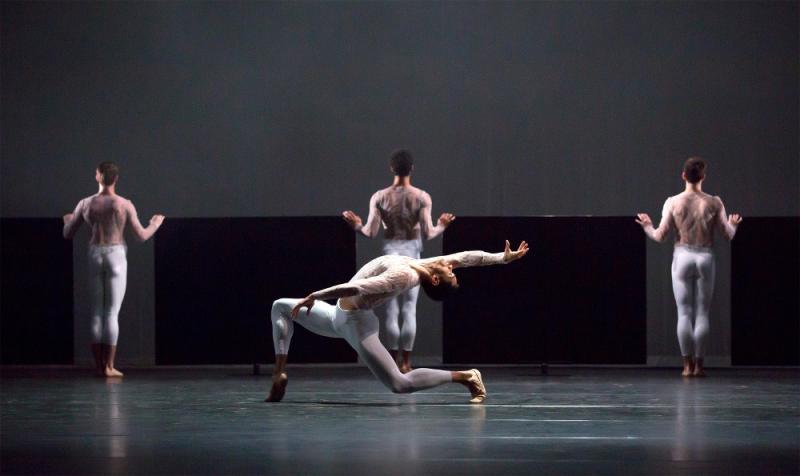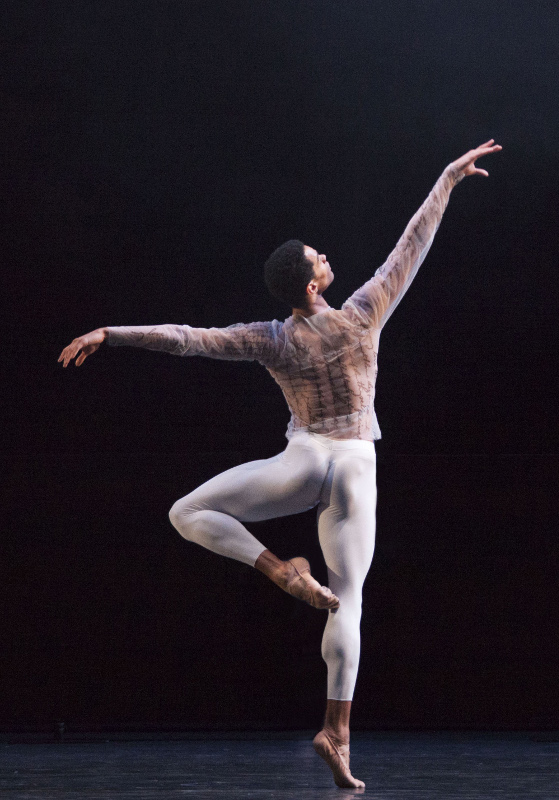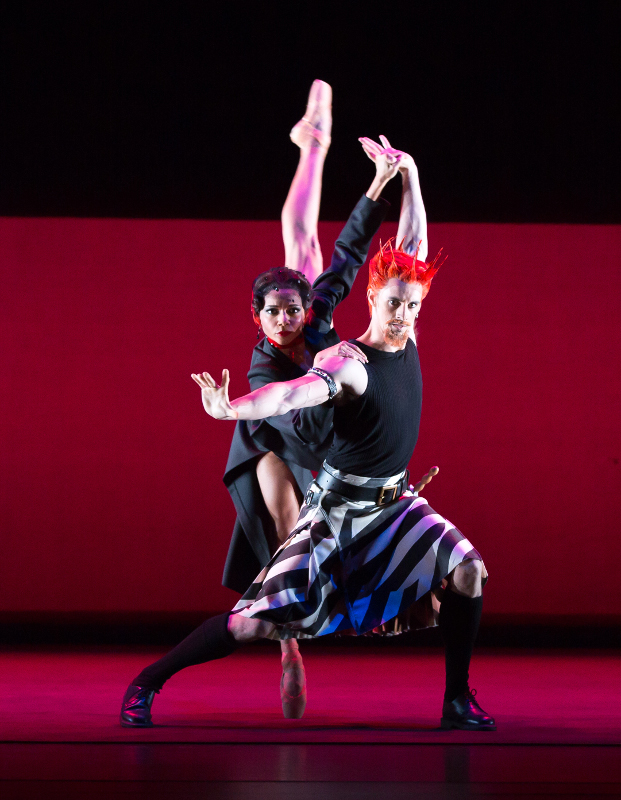Shakespeare triple bill, Birmingham Royal Ballet, Sadler's Wells | reviews, news & interviews
Shakespeare triple bill, Birmingham Royal Ballet, Sadler's Wells
Shakespeare triple bill, Birmingham Royal Ballet, Sadler's Wells
Creative renditions of the Bard's works in dance

Shakespeare has always been a fertile source of inspiration for story ballets.
Jessica Lang's Wink – created for the company and premiered earlier this year – takes the prize for formal ingenuity. It is a response to the sonnets, and goes far beyond simply emotional or narrative resonances. Wink's structure in a series of quartets and a duet mimics a sonnet's quatrains and couplets, for example, while the rotating of the black and white boards which constitute the set might be interpreted as a visual representation of iambs, the metrical "feet" which make up a sonnet's lines. Lang's neo-classical choreographic style and adherence to balletic structural conventions provide a much better response to the tightly regulated sonnet form than the sub-Pina Bausch tanztheater emoting chosen by Christian Spuck for his ballet on the same theme.
 Lang by no means neglects the emotional or the narrative content of the sonnets, but she rightly abstracts and distills it rather than seeking literal representation. Brandon Lawrence (pictured right), a dancer of noble bearing and gorgeous physique (I would love to see him do Siegfried or Albrecht), takes the most bard-like role: during the recitation of five sonnets, mostly about time, memory and loss, he dances solos which combine classical ballet's refined gestural conventions with a more expressionistic style to perfectly sonnet-like effect, both raw with emotion and formally contained. Lawrence also gets a well-constructed male-male pas de deux with blond Lewis Turner, surely recalling Shakespeare's Fair Youth. The more playful aspect of the sonnets is picked up on in several splendid petit allegro sections towards the end, while their romantic mode is captured in the first quartet, a rather soupy double duet.
Lang by no means neglects the emotional or the narrative content of the sonnets, but she rightly abstracts and distills it rather than seeking literal representation. Brandon Lawrence (pictured right), a dancer of noble bearing and gorgeous physique (I would love to see him do Siegfried or Albrecht), takes the most bard-like role: during the recitation of five sonnets, mostly about time, memory and loss, he dances solos which combine classical ballet's refined gestural conventions with a more expressionistic style to perfectly sonnet-like effect, both raw with emotion and formally contained. Lawrence also gets a well-constructed male-male pas de deux with blond Lewis Turner, surely recalling Shakespeare's Fair Youth. The more playful aspect of the sonnets is picked up on in several splendid petit allegro sections towards the end, while their romantic mode is captured in the first quartet, a rather soupy double duet.
The contrasts of mood between the three quatrains also struck me as potential echoes of Shakespeare's three main dramatic modes: tragedy in the first, lyric and darkly lit one; comedy in the second, sunny one; and history in the final one with its muscular lads and martial rhythm. Jakub Ciupinski's spare score of strings suits all three moods without overpowering any, and its gently insistent rhythm captures the feeling of Shakespeare's meter, while Peter Teigen's lighting plays with shadows, silhouettes, and black and white: picking up Mimi Lien's revolving boards, obviously, but also perhaps gesturing at the Dark Lady/Fair Youth contrast. The beauty of this ballet is that it generously provokes such reflection without dictating any one interpretation, while still being a fine piece of dance on its own terms.
José Limón's The Moor's Pavane (1949) is much more literal than Wink, being an explicitly narrative take on Othello, but like Lang, Limón understood the importance of structure when responding to Shakespeare: his piece is built on the form of a pavane, and it is within that framework that the four characters (not named as such, but Othello, Desdemona, Iago, and Emilia) enact a distilled version of the play, compelled by the convention of the dance to confront one another in circles of ever-increasing deceit and suspicion. Tyrone Singleton is a compelling Moor, broodingly charismatic in his red velvet, and he was ably supported by Delia Mathews as the Moor's Wife, Iain Mackay as His Friend, and Samara Downs as His Friend's Wife.
 After the spare elegance of Wink and the restraint of The Moor's Pavane, David Bintley's Shakespeare Suite, with its Duke Ellington score and kitschy cariacatures of Shakespeare's iconic couples, is a shock to the system, and not an entirely welcome one. It surely intends to be crowd-pleasing, but several segments feel laboured – Titania and Bottom's frolic is an irritating rather than engaging kind of madcap, and Romeo and Juliet's breathless teenage romance is likewise overdone. The odder ones are more interesting, like predatory Richard III with a Lady Anne who can't resist a bad man, while Céline Gittens's velvety lyricism contributes oodles of class to Lady Macbeth, whose subtly spiked shoulder pads are costume genius (pictured above left, Gittens with Iain Mackay as Macbeth). But the frantic "split-personality" Hamlet with a chorus line of dancers in mesh shirts tried my patience, and the Othello segment shows up woefully after The Moor's Pavane – we see Othello (played by Singleton again), bare-chested with Rasta braids, smother Desdemona, but we don't see his subsequent remorse and self-punishment, which makes the episode feel like a celebration of murder; not cool.
After the spare elegance of Wink and the restraint of The Moor's Pavane, David Bintley's Shakespeare Suite, with its Duke Ellington score and kitschy cariacatures of Shakespeare's iconic couples, is a shock to the system, and not an entirely welcome one. It surely intends to be crowd-pleasing, but several segments feel laboured – Titania and Bottom's frolic is an irritating rather than engaging kind of madcap, and Romeo and Juliet's breathless teenage romance is likewise overdone. The odder ones are more interesting, like predatory Richard III with a Lady Anne who can't resist a bad man, while Céline Gittens's velvety lyricism contributes oodles of class to Lady Macbeth, whose subtly spiked shoulder pads are costume genius (pictured above left, Gittens with Iain Mackay as Macbeth). But the frantic "split-personality" Hamlet with a chorus line of dancers in mesh shirts tried my patience, and the Othello segment shows up woefully after The Moor's Pavane – we see Othello (played by Singleton again), bare-chested with Rasta braids, smother Desdemona, but we don't see his subsequent remorse and self-punishment, which makes the episode feel like a celebration of murder; not cool.
The band under Paul Murphy played the Duke Ellington score with a vengeance, but frankly it was all a little too much for me, a crude comedown after two fine pieces. Bintley's Shakespeare Suite should be retired from the repertory of Bard-inspired dance, but Wink deserves to take its place alongside The Moor's Pavane as a classic of the genre.
- Birmingham Royal Ballet will perform The Tempest at Sadler's Wells 13-15 October and a triple bill of Wink, The Moor's Pavane, and The Dream at the Theatre Royal Plymouth 25-26 October.
- Read more dance reviews on theartsdesk
rating
Explore topics
Share this article
more Dance
 All You Need Is Death review - a future folk horror classic
Irish folkies seek a cursed ancient song in Paul Duane's impressive fiction debut
All You Need Is Death review - a future folk horror classic
Irish folkies seek a cursed ancient song in Paul Duane's impressive fiction debut
 MacMillan Celebrated, Royal Ballet review - out of mothballs, three vintage works to marvel at
Less-known pieces spanning the career of a great choreographer underline his greatness
MacMillan Celebrated, Royal Ballet review - out of mothballs, three vintage works to marvel at
Less-known pieces spanning the career of a great choreographer underline his greatness
 Carmen, English National Ballet review - lots of energy, even violence, but nothing new to say
Johan Inger's take on Carmen tries but fails to make a point about male violence
Carmen, English National Ballet review - lots of energy, even violence, but nothing new to say
Johan Inger's take on Carmen tries but fails to make a point about male violence
 WAKE, National Stadium, Dublin review - a rainbow river of dance, song, and so much else
THISISPOPBABY serves up a joyous tapestry of Ireland contemporary and traditional
WAKE, National Stadium, Dublin review - a rainbow river of dance, song, and so much else
THISISPOPBABY serves up a joyous tapestry of Ireland contemporary and traditional
 Swan Lake, Royal Ballet review - grand, eloquent, superb
Liam Scarlett's fine refashioning returns for a third season, and looks better than ever
Swan Lake, Royal Ballet review - grand, eloquent, superb
Liam Scarlett's fine refashioning returns for a third season, and looks better than ever
 First Person: Ten Years On - Flamenco guitarist Paco Peña pays tribute to his friend, the late, great Paco de Lucía
On the 10th anniversary of his death, memories of the prodigious musician who broadened the reach of flamenco into jazz and beyond
First Person: Ten Years On - Flamenco guitarist Paco Peña pays tribute to his friend, the late, great Paco de Lucía
On the 10th anniversary of his death, memories of the prodigious musician who broadened the reach of flamenco into jazz and beyond
 Dance for Ukraine Gala, London Palladium review - a second rich helping of international dancers
Ivan Putrov's latest gala was a satisfying mix of stars and young hopefuls
Dance for Ukraine Gala, London Palladium review - a second rich helping of international dancers
Ivan Putrov's latest gala was a satisfying mix of stars and young hopefuls
 Nelken: A Piece by Pina Bausch, Sadler's Wells review - welcome return for an indelible classic
A new generation of gifted performers for us to get to know
Nelken: A Piece by Pina Bausch, Sadler's Wells review - welcome return for an indelible classic
A new generation of gifted performers for us to get to know
 Dark With Excessive Bright, Royal Ballet review - a close encounter with dancers stripped bare
The Royal's Festival of New Choreography launches with an unforgettable walk in the dark
Dark With Excessive Bright, Royal Ballet review - a close encounter with dancers stripped bare
The Royal's Festival of New Choreography launches with an unforgettable walk in the dark
 La Strada, Sadler's Wells review - a long and bumpy road
Even the exceptional talents of Alina Cojocaru can't save dance adaptation of Fellini film
La Strada, Sadler's Wells review - a long and bumpy road
Even the exceptional talents of Alina Cojocaru can't save dance adaptation of Fellini film
 First Person: pioneering juggler Sean Gandini reflects on how the spirit of Pina Bausch has infiltrated his work
As Tanztheater Wuppertal Pina Bausch's 'Nelken' comes to Sadler’s Wells, a tribute from across the art forms
First Person: pioneering juggler Sean Gandini reflects on how the spirit of Pina Bausch has infiltrated his work
As Tanztheater Wuppertal Pina Bausch's 'Nelken' comes to Sadler’s Wells, a tribute from across the art forms
 Manon, Royal Ballet review - a glorious half-century revival of a modern classic
Fifty years on, Kenneth MacMillan's crash-and-burn anti-heroine is riding high
Manon, Royal Ballet review - a glorious half-century revival of a modern classic
Fifty years on, Kenneth MacMillan's crash-and-burn anti-heroine is riding high

Add comment